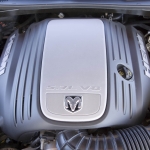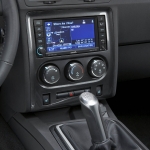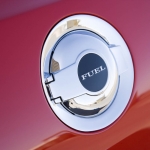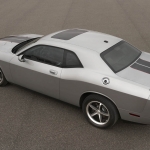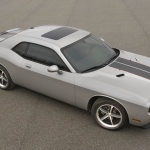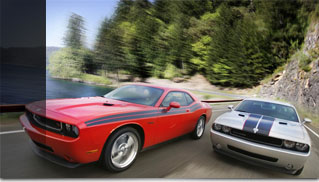 Pentastar V-6 Set to Roll Out Across Broad Range of New Chrysler Vehicles
Pentastar V-6 Set to Roll Out Across Broad Range of New Chrysler Vehicles
* New Pentastar is slated to be available across 13 vehicles, including trucks and sport utilities, by 2013
* Significant cost savings realized with shift from seven engines to one V-6 engine
* 2011 V-6 Challenger boosted 55 horsepower to 305 horsepower with new Pentastar V-6
* Introduced in 2011 Jeep® Grand Cherokee, new V-6 engine will soon be available in new Chrysler Town & Country, 300 and 200, and Dodge Charger, Avenger, Durango and Journey
* Designed for a range of specific applications, horsepower and torque are tuned for specific models
* Fuel efficiency improvement will average up to 7 percent across the model range.
October 21, 2010 , Auburn Hills, Mich. – Improved fuel efficiency, more power and reduced emissions, all hallmarks of the new Pentastar V-6 engine, will soon be available across 13 models from Chrysler Group LLC.
The Pentastar V-6, the most advanced six cylinder engine ever produced by Chrysler Powertrain group, is slated to be the ‘workhorse’ engine across many models and will eventually replace seven different V-6 engines over the next three years. By 2014, the new V-6 is expected to account for more than a third of the powertrains in the vehicle line-up and substantially contribute to an overall corporate fuel efficiency improvement of more than 25 percent. Read more!
“The Pentastar engine is suited to meet the requirements for a full range of vehicle applications in terms of power and fuel efficiency including passenger cars, mini-vans and sport utilities,” explained Bob Lee, vice president of engine engineering for Chrysler Group LLC. “It has been designed for today and many years to come. Already, we are looking forward to adapting future technologies as they become available to the Pentastar V-6 for even more fuel efficiency and performance.”
Compact and lightweight, Pentastar V-6 will be used in front-, rear- and all-wheel-drive models. Already standard on the new Jeep Grand Cherokee, the V-6 will gradually phase out seven V6 legacy engines ranging from 2.7 – liters, up to 4.0 – liters in the current product portfolio. Overall, the new Pentastar will enable Chrysler Powertrain to reduce major engine components from 189 parts to just 32, greatly simplifying the build process and improving quality. Significant cost savings also are realized with purchasing efficiencies and a reduction in limited, high piece cost parts.
Some parts, including the exhaust manifolds, will completely disappear by virtue of being cast directly into the cylinder head. Today, the engine line-up features 32 different left and right exhaust manifolds. That will drop to zero with the new Pentastar V-6.
Upper and lower intake assembles, which accounted for 21 and 11 different parts numbers (respectively) have been reduced to two upper and lower assemblies. Camshaft variations will drop from 14 to four and just two fuel rails will be required rather than the current 14.
Leading the way will be the 2011 Dodge Challenger that will be exclusively equipped with a higher horsepower version of the 3.6-liter Pentastar V-6. Certified by the Society of Automotive Engineers, the higher horsepower V-6 produces 305 bhp @ 6350 rpm – representing a 55 horsepower increase over the previous 3.5-liter V-6. Torque also is noticeably up with the V-6 rated at 268 lb.ft. @ 4800 rpm.
The increase in power and fuel efficiency is derived from technologies incorporated in the new engine and strategically developing both the intake and exhaust systems to take advantage of the compact engine layout and vehicle packaging.
“From day one, our objective with the new Pentastar V-6 engine always was to develop an engine that was capable of producing more than 300 horsepower,” according to Lee. “What we’ve done is adapt proven technologies to this new V-6 engine to bring even more power to Challenger for 2011”
Engine Structure
Constructed with a high-pressure, die cast aluminum block fitted with cast iron bore liners and aluminum cylinder heads, the 60-degree 3.6-liter Pentastar engine is compact and lightweight. At 503mm in total length, the new V-6-liter is 94mm shorter than the 3.7 engine that was previously used in the Jeep Grand Cherokee. Models including Charger, Challenger and Avenger have had engine length decrease 34mm from the previous 3.5 – liter V-6.
With this shorter length, engine packaging constraints are reduced. On Challenger, for example, this allowed engineers to improve both the intake flow and exhaust flow resulting in more power.
Bore and stroke measure 96mm by 83mm (respectively). Cast aluminum pistons with low friction rings are fitted to forged steel connecting rods. Pistons have been designed with a reduced skirt area to help reduce both weight and friction. Compression ratio for the engine is 10.2:1 for all applications.
The strong, lightweight pistons are cooled with piston cooling jets fitted in each cylinder that spray oil on the piston to more effectively control heat and help reduce the onset of detonation in the combustion chamber.
The nodular iron crankshaft also is common across all applications. Fatigue strength of the crankshaft was increased 83 percent with the rolled fillet process. The crankshaft is fitted with four bolts on the main bearing supports. Two additional bolts are cross-fitted in the main bearing caps providing an extremely rigid bottom end. Additionally, as part of the overall refinement of the Pentastar V-6, a structural windage tray is included to help reduce oil splash on the crankshaft and reduce power losses from the reciprocating assembly. The tray also improves structural stiffness and contributes to lowering engine noise.
New Oil System
Lubrication of the engine is through a variable displacement pump that adjusts the flow rate and pressure to minimize the energy used by the pump. The engine management system determines the oil pressure needs of the engine and commands an electronic solenoid to drive the pump into low or high pressure mode. If the engine is running below 3500 rpm, for example, the pump operates in the low pressure mode to conserve energy. When the engine is operating at more than 3500 rpm, the pump switches to high pressure.
A force balance mechanism inside the oil pump adjusts the size of the pumping chambers to deliver the appropriate oil flow to meet engine demands. If the oil is cold, less oil is needed and the pump reduces the size of the internal chambers. When the oil is hot and gets thinner, more oil is needed. A spring located inside the pump increases the size of the pump chambers. This action helps minimize the amount of energy required to pump the oil.
For consumers, oil changes are simplified with a paper filter located on top of the engine. To help reduce long term environmental impacts, the paper filter can be incinerated rather than disposed in a landfill. Crankcase capacity is six quarts of oil with a filter change. Traditional, non-synthetic motor oil with an ILSAC standard of GF5 is recommended. Change interval is 8000 miles under normal driving conditions.
High Flow Intake and Exhaust
Cylinder heads are constructed of T7 heat treated aluminum and feature dual overhead camshafts with roller finger followers. On the intake side, valve diameters are 39mm with 17 degrees relative to the bore axis. Exhaust valves are 30mm in diameter and canted at 18.8 degrees. Combustion chamber volume is 52.7cc.
Independent cam phasing also is used on all four camshafts. Torque actuated, the phasers use the natural action of the valve springs to pump the phasers into position, lowering the amount of energy required to move the phasers very quickly. The small size of the phasers combines to reduce weight and allows the camshafts to be spaced very closely together for optimum valve angles and combustion chamber geometry.
Induction is handled through a multi-point port fuel injection system and a lightweight composite intake manifold. Throttle bore diameter is 74mm. Both the intake and exhaust systems have been designed to provide efficient flow characteristics with a minimum amount of restriction in the passages. On the exhaust side, spent gases exit through an integral exhaust manifold that is cast into the cylinder head – unique in the Chrysler engine line-up.
The integral exhaust manifold eliminates the need for separate cast iron or steel exhaust manifolds and contributes to improvements in engine refinement and weight. The integral manifold also results in a broader range of stoichiometric operation reducing fuel consumption during mountain grade and trailer tow driving.
Extremely efficient with advanced emission technology, the new 3.6-liter Pentastar is designed for all future emission standards. This requires no Exhaust Gas Recirculation (EGR) and helps reduce the mass of the engine. The 3.6-liter V-6 will be introduced to meet Federal Tier 2 BIN 5 emission requirements and Ultra-low Emissions Vehicle II standards. The engine also has been designed to meet all known future worldwide emission standards including LEV III and PZEV California standards. For export applications, the Pentastar V-6 is capable of meeting Euro6 standards.
Despite the impressive gains in power, the engine is designed to run on regular unleaded fuel with an octane rating of 87. The engine also can run on E85 blended gasoline.
Lightweight and Powerful
Weight reductions are impressive. Fully dressed, the new Pentastar V-6 is 94 lbs. lighter than the 3.7-liter engine it replaced in Jeep Grand Cherokee. Similarly, while larger in displacement, Pentastar weighs 42 lbs. less than the 3.5-liter it replaces in the Chrysler 300 application.
Additionally, horsepower gains have been significant across all models. On the new Jeep Grand Cherokee, horsepower has increased dramatically from 210 horsepower from the 3.7-liter to 290 horsepower on the new Pentastar 3.6-liter engine – a 38 percent increase. On the new Avenger/200, horsepower has increased to 283 horsepower from 250. On models including the Chrysler Town & Country, horsepower also has skyrocketed to 283 with the new Pentastar V-6 – up 86 horsepower from the previous 3.8-liter. On Minivan models that were equipped with the 4.0-liter engine, horsepower is up 32 to 283 horsepower.
The soon-to-be-introduced Dodge Charger will feature more than new sheet metal. Under the hood, the Pentastar V-6 will provide another 42 horsepower, now 292 horsepower.
All models equipped with the new Pentastar V-6 engine will also benefit from increases in torque. More importantly, the 3.6-liter has a broad, flat torque curve with 90 percent of peak torque available between 1800 – 6350 rpm, providing customers with outstanding driveability and power.
Reliability & Refinement
Before the first aluminum block was cast, the new Pentastar V-6 benefited from more than 45,000 hours of computer analysis to optimize the design of the engine. Once assembled, the engines were thoroughly tested and evaluated on dynamometers and in vehicles. More than 12 million customer equivalent miles were logged on the dynos followed by vehicle testing of nearly 4 million customer equivalent miles.
Already recognized as one of the quietest V-6 engines available, world class NVH levels start with a stiff and lightweight block. To help reduce vibration, all components are bolted directly to the block eliminating bracket assemblies. To further reduce vibration, the engine and transmission connection is extremely rigid to eliminate motion between the two major assemblies.
“We feel the new Pentastar V-6 represents the best technology to deliver exceptional refinement, fuel economy and performance,” Lee said. “This engine allows increased flexibility to apply new technologies while providing significant cost savings to the company by substituting the state-of-the-art Pentastar for previous V-6 engines.”
2010 Dodge Challenger
